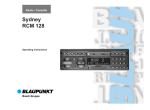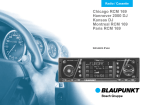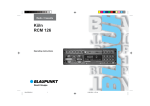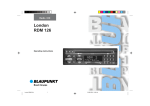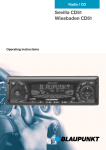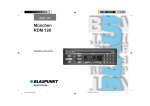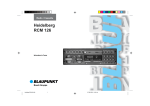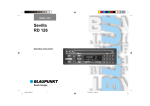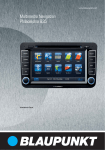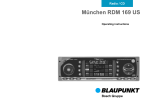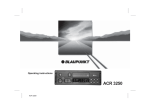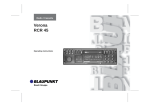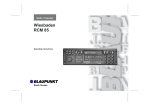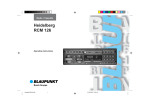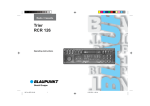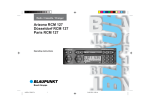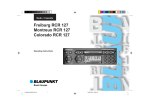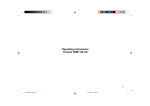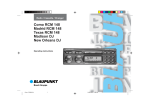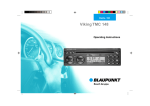Download Blaupunkt Toronto RDM 128 User's Manual
Transcript
Radio / CD Toronto RDM 128 Operating instructions 3 4 SVENSKA 5 6 7 ITALIANO 1 8 9 10 FRANÇAIS 16 15 14 13 NEDERLANDS 17 ESPAÑOL 2 18 PORTUGUÊS 20 19 11 12 ENGLISH ENGLISH Contents Quick reference ............................ 31 Important notes ............................ 37 Precautions ........................................... 37 Traffic safety ......................................... 37 Installation ............................................. 37 Telephone mute .................................... 37 Accessories .......................................... 37 KeyCard theft protection system ........................................... 38 Putting the unit into operation .............. 38 Removing the KeyCard ........................ 38 “Training” a second KeyCard/ Replacing a KeyCard ............................ 38 Displaying the radio pass data ............. 38 Short Additional Memory (S.A.M.) ........ 39 Turn On Message (T.O.M.) .................. 39 Optical indication for extra security ...... 39 Care of your KeyCard ........................... 39 Switching the audio source ........ 39 Radio operation with RDS ........... 40 AF - Alternative frequency .................... 40 REG - regional programme .................. 40 Selecting a waveband .......................... 40 Station tuning ........................................ 40 Automatic tuning / ....................... 40 Manual tuning with << >> .................. 41 Scrolling through the broadcasting networks (only FM) .................................... 41 Changing the memory bank (FM) ......... 41 30 Storing stations ..................................... 41 Automatically storing the strongest stations with Travelstore ............................ 42 Recalling stored stations ...................... 42 Scanning stored stations with Preset Scan .......................................... 42 Scanning stations with Radio-Scan ...... 42 Changing the scan time ........................ 42 Selecting the seek tuning sensitivity .... 42 Switching from stereo to mono (FM) .... 43 PTY – Programme Type ....................... 43 Switching PTY on/off ......................... 43 Programme type ................................... 43 Checking the programme type of the station .......................................... 43 Displaying the selected programme type .................................................... 43 Selecting a programme type ............. 43 Storing programme types .................. 44 Scanning stations with PTY-SCAN ... 44 PTY priority ........................................ 44 CD and CDC changer operation (optional) ....................................... 47 Receiving traffic programme stations with RDS-EON................ 45 DSC programming ....................... 52 Traffic announcement priority on/off .... 45 Warning beep ....................................... 45 Switching the warning beep off ......... 46 Automatic seek tuning start .................. 46 Adjusting the volume for traffic announcements and the warning beep 46 Adjusting GEO for traffic messages and the warning beep ........................... 46 Switching to CD operation .................... 47 Inserting a CD ....................................... 47 Removing a CD .................................... 47 Selecting a title ..................................... 47 MIX playback ........................................ 48 Switching to CDC operation ................. 48 Selecting CDs and titles ....................... 48 MIX playback ........................................ 48 Selecting the display mode .................. 49 Storing the display mode ...................... 49 SCAN operation .................................... 49 TPM Track Program Memory ............... 49 Storing tracks with TPM .................... 49 CD playback with TPM ...................... 50 Clearing TPM information ................. 50 Entering CD names .............................. 51 Deleting a CD name ............................. 51 Clearing TPM information and CD names with DSC-UPDATE ................... 51 Overview of the DSC factory settings .................................................. 54 Appendix ....................................... 55 Specifications ........................................ 55 Switching on/off via the ignition: When connected correspondingly, the set can also be turned on and off via the vehicle ignition. After the ignition has been switched off, a double beep tone will remind you that you should remove the KeyCard before leaving your vehicle. 3 For instantly muting the volume. By pressing the button the volume will be muted immediately. “MUTE” will appear in the display. The function is cancelled by pressing button or VOL+. When pressing VOL-, the normal volume will be by one grade lower than the mute volume. DEUTSCH FRANÇAIS Extra function FMT To store the six most powerful stations automatically with Travelstore: Press FMT until you hear a beep or “T-STORE” appears in the display. 5 M•L - toggle switch To toggle between medium and long wave reception. ITALIANO 4 FMT Press repeatedly to switch between the FM memory banks I, II and T (Travelstore). When pressing this button, the system will automatically switch to FM. NEDERLANDS Extra function Memory button in the DSC menu. SVENSKA Note: Read the information in chapter “KeyCard theft protection system”. 2 VOL+ / VOLTo alter the volume. Each time the set is switched on, it will play with the pre-adjusted volume (VOL FIX). You may also change the VOL FIX setting (see chapter “DSC programming”). To programme the mute volume level, proceed as follows: • Adjust the desired volume. • Press for two seconds until you hear a beep. Now this volume level is stored as your mute volume. ESPAÑOL Switching on/off with the KeyCard: The set has to be turned on via the ON button. Switching on with the ignition being switched off: To keep on operating the set when the ignition is switched off (KeyCard is inserted), proceed as follows: Press ON after the double beep tone. The unit will be turned on. To avoid that the battery goes flat, the system will be turned off automatically after a playback time of one hour. PORTUGUÊS 1 Switching on/off with the ON button: Press ON. When switching the set on with the ON button, the KeyCard has to be inserted. The unit will play with the pre-adjusted volume. ENGLISH Quick reference 31 6 Rocker switch Radio operation / Station search Up Down <</>> Up/Down in short intervals when AF is off <</>> To scroll through the station networks when AF is on, e.g. NDR 1, 2, 3, 4, N-JOY, FFN, ANTENNE ... . CD operation / Title selection Changer operation (optional) Up Down Press once to go back to the beginning of the current title. CD selection Fast advance, audible (CUE). Hold down as long as required. Title selection Fast reverse, audible (REVIEW). Hold down as long as required. Up Down Upwards: Press briefly. CUE - fast advance (audible): Keep depressed. Downwards: Press as many times as required. To restart a title: Press briefly. REVIEW - fast reverse (audible): Keep depressed. Extra rocker switch functions: Further setting functions with AUD D GEO C DSC MODE B PTY > Condition: The corresponding function has to be activated. 32 n o 8 KeyCard theft protection system To operate the set it is necessary that the KeyCard is inserted. p c a) NDR2 - Station name b) VIVALDI - CD name or c) 1 : 52 - CD time (playback time) and number for changer operation (optional) d) FM - Waveband e) 6 - Preset button (1-6) f) I, II, T - Memory bank I, II or Travelstore g) CD-IN - A CD is inserted - Stereo h) i) lo - Seek tuning sensitivity j) AF - Alternative frequency for RDS operation k) TA - Priority for traffic stations l) TP - A traffic station is being received KeyCard For this purpose, introduce the KeyCard (with the contact area showing up) into the slot above the tongue sticking out of the unit. To remove the card, press first to unlock. Read also the information in chapter “KeyCard theft protection system”. Flashing KeyCard tongue When the radio is turned off and the KeyCard removed, the KeyCard tongue can be programmed to flash for optical theft protection. For more information see chapter “DSC programming”. DEUTSCH ENGLISH Radio operation Scan Press SC/MIX briefly – “FM SCAN” and the name of the scanned station will alternately appear in the display. The unit will scan all stations which can be received. Preset Scan Press SC/MIX for approximately two seconds until you hear a beep. “SCAN” and the name of the scanned station will alternately appear in the display. The unit will scan all stations stored on the preset buttons. To stop Scan / Preset Scan: Press SC/MIX once again. FRANÇAIS b e f g hi j k l m ITALIANO d 9 SC/MIX NEDERLANDS p) T5 This flashlight can be switched off by pushing in the tongue and lock. SVENSKA o) TPM a - Programme type function - CD playback in random order - To select and store CD titles - Track no. 5 is played back CD operation MIX playback The Mix function is switched on if “MIX” appears in the display. The CD tracks will be played at random. To switch Mix on and off: Press SC/MIX briefly. 33 ESPAÑOL m) PTY n) MIX PORTUGUÊS 7 Display CD-Scan Press SC/MIX for approximately two seconds until you hear a beep. “CD-SCAN” appears in the display. The unit will scan all CD titles. To stop CD-Scan: Press SC/MIX once again. Changer (CDC) operation (optional) MIX CD The CD titles will be played at random. The individual discs are selected in numeric order. MIX MAG The CD titles will be played at random. The individual discs are also selected in random order. MIX OFF The Mix function is deactivated. Press SC/MIX as many times until the desired function briefly appears in the display. CD-Scan Press SC/MIX for approximately two seconds until you hear a beep. “CDC-SCAN” will appear in the display. All CD titles will be scanned briefly. 34 To stop CD-Scan: Press SC/MIX once again. : lo•CLR Radio operation < TA (priority for traffic announcements) When “TA” lights up in the display, the system will play traffic stations only. Priority on/off: Press TA. = AF To switch the seek tuning sensitivity level: Press button briefly. To switch between mono and stereo reception: Press button for approximately two seconds (beep). The stereo symbol will disappear for mono playback. Radio operation CD and CDC operation (optional) Regional function on/off: Press the AF button for approximately two seconds until you hear a beep. “REG-ON” or “REG-OFF” will appear in the display (see chapter REG - regional programme). To clear CD titles from the TPM memory. ; TPM (Track Program Memory) To select and store titles during CD/ CDC playback. In each operating mode it is possible to manage a maximum of 30 discs. Please refer to chapter “TPM programming”. Alternative frequency during RDS operation: When “AF” lights up in the display, the system will automatically seek a frequency offering better reception of the same RDS programme. AF on/off: Press AF briefly. CD operation To switch between the name and time (playback time) display modes: Press AF briefly. • SRC SRC (source) When having a CD inserted you can switch between the different audio sources radio, CD, and CDC/AUX (if activated). (Eject) Hold down the button for approximately two seconds (beep) and the CD will eject. DEUTSCH ENGLISH FRANÇAIS ITALIANO Extra function preset buttons To store and recall a PTY programme type. On FM, you can store and recall one programme type on/from each preset button when PTY is active (“PTY” lights up in the display). NEDERLANDS ? SVENSKA > PTY (Programme Type) In the PTY mode, the preset buttons become programme type buttons. With each preset you can select one programme type, such as for example NEWS, SPORT, POP MUSIC, EDUCATE, etc. B DSC (Direct Software Control) Use the DSC function to customise certain programmable, basic settings to suit your personal needs and preferences. See chapter “DSC programming” for more information. A CD slot When inserting a disc with the label side facing up, it will be pulled in automatically and transported to the playback position. CD playback is adjusted automatically. ESPAÑOL To switch between the name, time (playback time) and number (CD number) display modes: Press AF briefly. @ 1, 2, 3, 4, 5, 6 - preset buttons On FM, you can store six stations for each of the memory banks I, II and T. On MW/LW, you can store six stations each. To store a station: Press a preset button during radio operation and hold down until the set resumes play after the muting and you hear a beep. To recall a station: Select the desired waveband. On FM, adjust the corresponding memory bank and press the relevant preset button briefly. PORTUGUÊS CDC operation (optional) 35 C GEO To adjust the balance (left/right) and fader (front/rear) with the rocker switch. Fader front Fader rear Balance left Balance right The last setting will be stored automatically. To switch off GEO: Press button once again. If the setting remains unchanged within four seconds, the display will switch back to the previous condition. Extra function GEO Separate balance and fader settings for traffic messages. See chapter “Adjusting GEO for traffic messages and the warning beep”. 36 D AUD To adjust the treble and bass frequencies with the rocker switch. Treble + Treble – Bass – Bass + The last setting will be stored automatically. To switch off AUD: Press button once again. If the setting remains unchanged within four seconds, the AUD setting will be terminated automatically. Extra function AUD Loudness: When listening at a low level, the Loudness function will create a more natural sound by emphasising the low frequency range. To switch the Loudness on/off: Press the AUD button for approximately two seconds until you hear a beep. The Loudness function is active if “LD” appears in the display. For more information see chapter “DSC programming”. Precautions Installation Accessories Before starting to use your new car radio, please read the following information carefully. If you would like to install your new car stereo yourself or add other audio components to existing ones, then please read carefully the enclosed instructions on installation and connection. In order to ensure that the set operates properly it is necessary that the positive power supply line is connected via the ignition and the permanent +12 V lead. Do not ground the loudspeaker outputs! Use only the accessories and spare parts approved by Blaupunkt. FRANÇAIS Remote control With the infrared remote control RC 05 you can control all of the important functions of your car hi-fi system from the steering wheel. SVENSKA NEDERLANDS If you have a mobile telephone installed in your vehicle, radio or CD playback can be muted automatically when using the phone (telephone mute). “PHONE” will then appear in the display. When TA is active, traffic messages will always have priority. The announcement will be aborted by pressing the TA button. ITALIANO Telephone mute Changer CDC A 05 or CDC F 05 ESPAÑOL As the driver of a motor vehicle, it is your responsibility to pay attention to the traffic situation at all times. Never use your car radio in a way that could distract you. Please keep in mind that you travel a distance of 14 m per second at a speed of only 50 km/h. Should the traffic situation become particularly demanding, we advise you not to use the radio. Always make sure that you are still able to hear any warning signals coming from outside of the vehicle, such as police or fire engine sirens, so that you can react accordingly. Therefore, you should always select a moderate volume for playing your car radio while you are driving. Amplifier All Blaupunkt amplifiers PORTUGUÊS Traffic safety You can use the following Blaupunkt products with this car stereo: ENGLISH DEUTSCH Important notes 37 KeyCard theft protection system This car radio is supplied with one KeyCard as standard, though it can also be operated with a second card. If you have lost your KeyCard or if it was damaged, you can buy a new one from your specialised dealer. When using two KeyCards, the settings stored on the first card will be adopted. However, you can individually store the following functions: Preset button assignments, bass, treble, balance and fader settings, Loudness, TA (traffic announcement volume), beep volume. In addition, the settings activated before switching the radio off, such as the waveband, station, TA priority, AF, REG ON/OFF, SCANTIME, seek tuning sensitivity and VOL FIX will also remained stored. This ensures that you will find your basic settings re-adjusted automatically as soon as you have inserted your KeyCard. Putting the unit into operation • Turn on the set. Introduce the KeyCard into the slot with the contact area showing up (KeyCard tongue sticking out). The car radio is now ready for operation. If a wrong KeyCard is inserted, then “CARD 38 ERR” will appear in the display. In this case please do not make any further adjustments. The system will switch off after approximately ten seconds. When inserting another card type (e.g. phone or credit card), the display will show “WRONG KC” for approximately two seconds. Remove the wrong card and introduce the correct KeyCard. After the display indications “CARD ERR” or “WRONG KC”: • Press ON to turn on the set. Removing the KeyCard Never pull out the KeyCard directly! • First, slightly push in the KeyCard. This releases the card and puts it in the proper position for being removed. • Now you can pull it out. • Press << or >>. The display will switch to “CHANGE”. • Push in the KeyCard. The card is released and put in the proper position for being removed. • Remove the first KeyCard and insert the new one while “CHANGE” is still being displayed. After the display indication “READY” or “LEARN KC”, • press DSC. Now you can also use the new KeyCard for operating your unit. A maximum of two cards can be used for the set. When trying to “train” a third one, the access authorisation for the KeyCard not used for the “training” process will be deleted automatically. Displaying the radio pass data “Training” a second KeyCard/ Replacing a KeyCard While operating the unit with the first KeyCard, you can “train” a second one to be also used with the set: • Insert the first KeyCard and turn on the set. • Press the DSC button and select “LEARN KC” with / . Using the KeyCard supplied with your set you can have the radio pass data such as the model name, product number (7 6 ...) and serial number indicated on the display panel. Please refer to chapter “DSC programming - READ KC”. When the vehicle is stationary and the KeyCard removed, the KeyCard tongue can be switched to flash for extra anti-theft security. For this it is necessary that the positive power supply line and the permanent +12 V lead are connected such as described in the installation instructions. Be sure that “LED ON” is adjusted in the DSC mode. If required, please refer to chapter “DSC programming - LED”. CD, or CDC (AUX) AUX is only available if no Blaupunkt changer CDC A05 or CDC F05 is connected. “AUX ON” must be adjusted in the DSC menu. The CD mode is only available if a disc is inserted. To switch to another mode, • press SRC briefly. Turn On Message (T.O.M.) Switching off the flashlight SVENSKA The flashlight can be switched off by pushing in the KeyCard and lock. If you would like to deactivate the flashing tongue with general effect, adjust the relevant item in the DSC menu to “LED OFF”. ESPAÑOL Care of your KeyCard For a proper function of the KeyCard it is important that the contacts are free from any foreign particles. Avoid direct skin contact. If necessary, clean the KeyCard contacts using a cotton swab soaked with alcohol. PORTUGUÊS The second KeyCard available from your specialised dealer also allows you to display a special turn-on message each time the radio is switched on. The freely selectable text with a maximum of 48 characters can be programmed by all dealers who have the required equipment available. The programmed text will be displayed each time you turn on your system with the second KeyCard. DEUTSCH Flashing KeyCard tongue ENGLISH The second KeyCard available from your specialised dealer offers you the possibility to read out any short information, which will be moved through the display, such as, for example, the phone number of your car dealer or the emergency call number of your automobile association. Please refer to chapter “DSC programming - READ KC”. The freely selectable text with a maximum of 48 characters can be programmed by all dealers who have the required equipment available. Using the SRC button you can switch between the following audio sources: radio, FRANÇAIS Optical indication for extra security NEDERLANDS Short Additional Memory (S.A.M.) ITALIANO Switching the audio source 39 Radio operation with RDS (Radio Data System) The Radio Data System offers you more convenience when listening to FM radio stations. More and more radio stations have begun to broadcast RDS information alongside their programmes. As soon as a programme has been identified, the station name including a regional identifier, if applicable, will appear in the display, for example, NDR1 NDS (regional programme in Lower Saxony, Germany). When RDS is activated, the preset buttons become programme buttons. You now know exactly which programme you have tuned into, making it easy to find the desired station quickly. But RDS offers you further advantages: AF - Alternative frequency The AF (Alternative Frequency) function makes sure that the strongest frequency of the currently selected programme is always tuned in automatically. This function is activated when “AF” appears in the display. In order to switch this function on or off, • press the AF button briefly. While searching for the strongest reception signal, the radio may switch to mute briefly. 40 If “SEARCH” appears in the display when switching on the radio or recalling one of the stored frequencies, the unit is automatically searching for an alternative frequency. “SEARCH” will disappear from the display when the alternative frequency has been found or after the frequency band has been run through completely. If the reception quality of the selected programme becomes too bad: • Tune into another station. REG - regional programme Certain radio programmes are split up at times into regional programmes offering local information. The 1st programme broadcast by NDR, for example, offers programmes with different contents in the northern states of Germany SchleswigHolstein, Hamburg and Lower Saxony at certain times of the day. If you are listening to one programme and move to an area where another linked regional programme becomes stronger, the unit will switch to that programme. If you wish to continue listening to the first programme, • press the AF button for approximately two seconds. “REG ON” appears in the display. If you leave the service area of the regional programme tuned into, or if you would like to take advantage of the full RDS service, switch to “REG OFF”. • Press the AF button for approximately two seconds until “REG OFF” appears. “REG ON” or “REG OFF” will be briefly displayed each time the radio is switched on. Selecting a waveband With this car radio you can select between the following wavebands: FM 87.5 - 108 MHz MW 531 - 1602 kHz LW 153 - 279 kHz • Select the desired waveband by pressing the FMT or M•L button. To toggle between MW and LW: • Press M•L. Station tuning Automatic tuning • / Press / ; the car radio will automatically search for the next station. When keeping the upper or lower part / of the rocker switch depressed, seek tuning will speed up in upwards or downwards direction. You can shift between the memory banks I, II and T in order to store stations and recall them later. The currently selected memory bank is indicated in the display. Condition: AF and PTY must be switched off (i.e. the symbols do not light up in the display). Press << >>; the frequency will change in short intervals in downwards or upwards direction. When holding the right or left part of the rocker switch depressed, the frequency scan is speeded up. DEUTSCH Tune in a station with the rocker switch (either automatically / or manually << >>). • Press the desired preset button until the radio resumes play after the muting (takes approximately two seconds, confirmed by beep). Now the station has been stored. The activated preset button is indicated in the display. Should you tune in a station which has already been stored before on another memory bank, the corresponding preset button and the memory bank will briefly flash in the display. 41 FRANÇAIS • You can also tune in a station manually. • ITALIANO Changing the memory bank (FM) Notice: Manual tuning with << >> On FM, you can store six stations on the preset buttons 1-6 for each of the memory banks I, II and T. On MW/LW, you can store six stations each. • Select the appropriate waveband with FMT or M•L. NEDERLANDS Manual tuning: Seek tuning Up Down Down in short intervals (“AF” must be switched off) Up in short intervals (“AF” must be switched off) Storing stations SVENSKA If necessary, deactivate these functions: • Press AF or PTY. You can use the << >> buttons to tune in stations of your reception area. If several programmes of the broadcasting networks can be received, you can scroll through them in forwards direction pressing >>, or backwards using the << button, e.g. NDR 1, 2, 3, 4, N-JOY, FFN, ANTENNE ... For this it is necessary that the stations have been tuned in at least once and that “AF” is active (lights up in the display). For this purpose, you may start Travelstore seek operation: • Press FMT for two seconds; the system starts to run through the frequency band. If “AF” does not light up, • press AF. With this, the requirements for selecting stations with << >> are fulfilled. ENGLISH Press the FMT button as many times until the desired memory bank lights up in the display. ESPAÑOL • PORTUGUÊS Scrolling through the broadcasting networks (only FM) Automatically storing the strongest stations with Travelstore You can automatically store the six most powerful FM stations of your current reception area sorted according to their signal strength. This function is particularly convenient on longer trips. • Press the FMT button for two seconds. “T-STORE” will appear in the display. The six strongest FM stations will be automatically stored on the memory bank “T” (Travelstore). When this process has been completed, the radio will play the first station. If desired, stations can also be stored manually on the Travelstore bank (see “Storing stations”). Recalling stored stations You can recall any stored station at the touch of a button. • Select the waveband by pressing FMT or M•L. On FM, also choose the corresponding memory bank by pressing the FMT button as many times until the desired bank appears in the display. • 42 Press the corresponding preset button briefly to recall the station. Scanning stored stations with Preset Scan You can have all of the stored stations briefly scanned on all wavebands. To start Preset Scan: • Press SC/MIX for approximately two seconds. All of the stored stations of the adjusted waveband will be scanned one after the other. The memory bank and preset position of the currently scanned station will flash in the display. To select a scanned station and switch off Preset Scan: • Press SC/MIX briefly. Scanning stations with Radio-Scan You can also scan all stations which can be received. To start the Scan function: • Press SC/MIX briefly. The scanned frequency or the station name will start flashing in the display. During the actual scanning process “SCAN” will be displayed. To select a scanned station and switch off the Radio-Scan function: • Press SC/MIX briefly. If no station is selected, the scan function will be automatically switched off after the frequency band has been run through completely. The unit will tune in the station listened to before starting the scan. Changing the scan time The scan time can be changed from between five to a maximum of 30 seconds. Please refer to chapter “DSC programming - SCANTIME”. Selecting the seek tuning sensitivity You can alter the automatic seek tuning sensitivity. If “lo” is displayed, the radio will only pick up strong, local stations (low sensitivity). If “lo” does not light up, the radio will also pick up weaker, distant stations (high sensitivity). The sensitivity level can be altered in both modes (see also chapter “DSC programming”). Switching PTY on/off • Press PTY. When the function is active, the programme type selected last will briefly appear in the display. “PTY” will be permanently indicated in the lower right corner of the display panel. NEWS CURRENT AFFAIRS INFORMATION SPORT EDUCATE DRAMA CULTURE SCIENCE VARIED POP MUSIC ROCK MUSIC M.O.R. M (middle of the road music) LIGHT M (light classical) CLASSICS (serious classical) OTHER M (other music) • Press << or >>. The programme type selected last will be displayed briefly. Selecting a programme type a) Using the preset buttons When PTY is switched on, you can use the preset buttons 1-6 to select the programme types stored at the factory. • Press one of the presets 1 - 6. The selected programme type will be displayed for two seconds. If you wish to listen to a station with this PTY, • press / eration. to start seek tuning op- PTY 16 to PTY 30 are not yet assigned. 43 FRANÇAIS ENGLISH DEUTSCH Displaying the selected programme type ITALIANO Press PTY for approximately two seconds. After the beep tone the display will show the programme type offered by the tuned in station. If “NO PTY” appears in the display, the current station has no PTY code. NEDERLANDS PTY is an RDS service offered by more and more radio broadcasters. This feature allows you to select FM stations according to their programme type. After you have chosen the PTY of your preference, the corresponding stations can be selected either by seek tuning or using the scan function. • SVENSKA PTY – Programme Type Use << >> to have the last selected programme type displayed and to choose a new one. You can select any one of the stored types with the preset buttons 1 - 6. Condition: PTY must be active. Using DSC you can choose between German and English (see “DSC programming PTY LANG”). All of the programme types listed below are available. The letters printed in bold are identical to the actual short-time indication in the display. Checking the programme type of the station ESPAÑOL If reception is poor, you may get better sound quality by switching to mono: • Press the lo button for approximately two seconds. With mono playback, the stereo sign will disappear from the display. Each time the radio is switched on, stereo playback is activated. The unit will automatically switch to mono if the received signal is not strong enough for stereo playback. Programme type PORTUGUÊS Switching from stereo to mono (FM) If the system is unable to find a station offering the selected programme type, the display will show “NO PTY” and a beep tone will be released. The station received before starting seek tuning will be tuned in. You can assign different programme types to each preset position. Please refer to the next chapter “Storing programme types”. b) Using the << >> buttons of the rocker switch When PTY is switched on, you can select a programme type using buttons << >>. • • • Press << or >>; the programme type selected last will be displayed for three seconds. During this period press >> (forwards) or << (backwards) to select the desired type. Press << or >> as many times as required. If you wish to listen to a station offering the selected PTY, • press / to start seek tuning operation. If the system is unable to find a station offering the selected programme type, the display will show “NO PTY” and a beep tone 44 will be released. The station received before starting seek tuning will be tuned in. Storing programme types One programme type was assigned to each of the preset buttons 1-6 at the factory. If desired, you can also store other available programme types. To do so, make sure that “PTY” lights up in the display. • If necessary, press the PTY button to switch on the function. • Select a programme type using buttons << >> and • hold down the desired preset button (1-6) until you hear a beep. Now the selected programme type can be recalled by pressing this preset. For this the PTY function must be active. Scanning stations with PTY-SCAN Condition: “PTY” must appear in the display. • Press the SC button. All received stations offering the selected programme types will be scanned. To switch off PTY-SCAN: • Press SC once again. PTY priority Situation: PTY is switched on and lights up in the display. No station offering the selected programme type can currently be received (with seek tuning or scan). The set will switch back to the previous station. As soon as a programme with such PTY can be received within the broadcasting network, the unit will switch over to the corresponding station for the duration of the programme. Example: German broadcasting network NDR: - Station tuned in: NDR3. - “PTY” lights up in the display. - Programme type “POP” selected. - Seek tuning is started. - No station with “PTY-POP” can be found. - The display shows “NO PTY” and - automatically switches back to NDR3. - NDR2 airs a “PTY-POP” programme. - The system will switch to the linked station NDR2 for the duration of the “POP” programme. Warning beep If you leave the reception area of the traffic programme station currently tuned into, you will hear a warning beep after approximately 30 seconds. This alarm tone will also be released when pressing a preset button which has no traffic programme allocated to it. ENGLISH FRANÇAIS ITALIANO NEDERLANDS If the priority for traffic announcement programmes is activated, “TA” will light up in the display. To switch the priority on or off: • Press the TA button. When pressing TA while a message is being broadcast, this message will be interrupted. The unit will then switch back to the previous condition. The priority for other traffic messages remains active. Please note that several buttons have no function while a traffic announcement is broadcast. SVENSKA Traffic announcement priority on/off ESPAÑOL Notice: As earlier mentioned, these functions are currently only supported by a limited number of RDS stations. The abbreviation “EON” stands for Enhanced Other Networks, meaning the exchange of information within a radio network. Many FM broadcasters offer traffic messages for their service area at regular intervals. All traffic programme stations transmit a special carrier signal alongside their programmes, which is decoded by your car radio. If this signal is identified, “TP” will appear in the display (Traffic Programme). In addition to these, there are also stations which do not actually transmit traffic programmes themselves, but by using RDSEON they offer the possibility to receive the traffic messages broadcast by another traffic programme station in the same radio network. If you wish to have the priority for traffic announcements activated while listening to one of these stations (e.g. NDR3), “TA” must appear on the display panel. If a traffic announcement is broadcast, the radio will automatically switch to the linked traffic programme station (in this case, NDR2) for the duration of the message and return to the original programme (NDR3) afterwards. PORTUGUÊS During CD or CDC operation, the set will also switch to the programme offering the selected PTY within the broadcasting network. After the PTY programme the system will remain in the radio mode. DEUTSCH Receiving traffic programme stations with RDS-EON 45 Switching the warning beep off a) Tune into another station offering traffic information: • Press the rocker switch or • press a preset button which has a traffic programme station allocated to it. Alternatively: b) Switch off the priority for traffic announcements: • Press TA. “TA” will disappear from the display. Automatic seek tuning start (CD and CDC operation) When leaving the reception area of the tuned in traffic programme station while listening to a CD, the system will automatically start searching for a new TA programme. If no such station is found within approximately 30 seconds, CD operation will be stopped and a warning beep will sound. To switch the warning beep off, proceed as described above. 46 Adjusting the volume for traffic announcements and the warning beep This volume was preset at the factory, though you can alter the value using the DSC function (see “DSC programming, TA VOL”). Adjusting GEO for traffic messages and the warning beep You can separately adjust the balance and fader settings for both traffic announcements and the warning beep. For example, it is possible to listen to traffic reports via the front left (right) speaker only. This provides the driver with the important traffic information without bothering the rear passengers too much. To make a setting: • During an announcement, adjust the balance and fader settings to suit your personal preferences. Make sure that a disc is inserted, “CD IN” shows on the display panel. Inserting a CD • • Switch on the radio. Insert a CD with the label facing up without the use of force. The CD will be transported to its playing position automatically. CD playback will start. / Title selection Up Down Press once to go back to the beginning of the current title. Fast advance, audible (CUE). as long as required. Hold down Fast reverse, audible (REVIEW). as long as required. Hold down Press the rocker switch as many times until you have reached the desired title. The number displayed beside “T” indicates the track number of the currently played title. ENGLISH PORTUGUÊS Press SRC to go through the available audio sources: • Press as many times until the display briefly shows “CD”. FRANÇAIS After having inserted the CD, the activated CD functions will appear on the display panel. If the TPM indicator is inactive, you can select and play all CD titles. If “TPM” lights up, you can only select and play the titles programmed with TPM. Press the button for approximately one second (beep). The CD will be ejected. To protect the CD mechanism, do not impair or try to help the automatic insertion and ejection of the disc in any way. If the CD is not removed within approximately 30 seconds, it will be re-inserted automatically. ITALIANO • NEDERLANDS Switching to CD operation Selecting a title SVENSKA CD operation Removing a CD ESPAÑOL This car stereo is equipped with a CD drive. In addition, it offers you convenient control of a Blaupunkt CD changer CDC-A05 or CDC-F05. These changers are not included in the scope of delivery and can be purchased from your specialised dealer. DEUTSCH CD and CDC changer operation (optional) 47 MIX playback Selecting CDs and titles When the MIX function has been activated, the CD tracks will be played in random order. “MIX” will then appear in the display. You can have the CD tracks played in random order. MIX CD In order to switch the MIX function on or off, • press SC/MIX briefly. CDC operation (optional) CD selection Up Switching to CDC operation Make sure that at least one CD has been inserted into the magazine. Press SRC to go through the available audio sources: • Press as many times until the display briefly shows “CDC”. 48 MIX playback Down Title selection Upwards: Press briefly. CUE - fast advance (audible): Keep depressed. Downwards: Press as many times as required. To restart a title: Press briefly. REVIEW - fast reverse (audible): Keep depressed. – The titles of the selected CD will be played at random. The next disc will be selected in numeric order. MIX MAG – CDC-A 05 / CDC-F 05 All titles of the CD will be played at random. The next disc will then also be selected and played randomly, etc. MIX OFF – The Mix function is deactivated. Discs and titles will be selected in numeric order. To alter the setting: • Press SC/MIX as many times until the desired function is briefly displayed. If the function is active, “MIX” will appear in the right display corner. DEUTSCH Selecting the display mode You can store your preferred display mode which will then be active each time the radio is switched on. If required, • press AF as many times until the desired setting is displayed. Use this feature to programme and play your favourite CD titles. Up to 30 CDs can be managed in the CD mode, up to 99 discs in the CDC mode. • Make sure that the TPM function is switched off (“TPM” not shown on the display panel). If you have not yet stored a track in the TPM, the function will be unavailable. If required, • switch TPM on/off by pressing the TPM button. – The elapsed playback time of the title is displayed, for example “2 : 32”. In addition for CDC operation: “NUMBER” – The CD position in the magazine (disc number) is displayed, for example “CD 8”. To switch the display mode: • Press the AF button during CD playback. The display mode and the corresponding setting or value will briefly show on the display panel, e.g. “TIME”, “2 : 32”. If you have selected “NAME” without having specified a name for the corresponding disc, “CD PLAY” will appear in the display. Please read also the chapter “Entering CD names”. SCAN operation Use this function to scan all of the CD tracks. For CDC operation, the system will scan the titles of all discs. To start the Scan function: • Press SC/MIX for approximately one second. The titles will be scanned one after the other in ascending order. To stop the Scan function: • Press SC/MIX once again briefly. The track currently being scanned is continued to be played. SCAN will also be terminated by • pressing one of the buttons AUD, GEO, DSC, SRC, TPM, , << >> or / . • Use / to select a track. The track number will be displayed. NEDERLANDS “TIME” Hold down the AF button until you hear a beep. Storing tracks with TPM • Hold down the TPM button until you hear a beep. Now the track has been stored. With CDC operation, a “ “ symbol will appear in front of the CD name. Then select the next track with / and store with TPM, as detailed above. You can also store a track at any time during CD playback. For this it is necessary that “TPM” and “SCAN” are deactivated. Programme TPM information for other CDs in the same way. 49 SVENSKA – The specified name, for example “MADONNA” will be displayed. ESPAÑOL “NAME” PORTUGUÊS You can select the desired display mode for CD operation: ENGLISH TPM Track Program Memory FRANÇAIS Storing the display mode ITALIANO CD and CDC operation CD playback with TPM • The TPM function must be switched on (TPM on/off with the TPM button). The tracks stored with TPM will be played in ascending order. Any tracks which were not stored will be skipped over. Clearing TPM information Using the CLR (clear) button, you can clear single tracks, all of the tracks for one CD or the entire Track Programme Memory. For CDC operation, you can also clear the TPM information of either the inserted magazine or all magazines. In order to clear any of this information, TPM must be switched on (“TPM” lights up in the display). If the TPM contains no data, then “NO TPM” will appear in the display. CD operation a) Clearing a track from the TPM: Switch on TPM. • Switch on TPM. • Press the CLR button for approximately four seconds until “CLR DISC” appears in the display. • Press the CLR button for approximately eight seconds until “CLR CD” appears in the display. Now this disc has been cleared from the TPM. c) Clearing all CDs from the TPM: Now this disc has been cleared from the TPM. c) Clearing a magazine from the TPM: • Switch on TPM. • Switch on TPM. • Press the CLR button for approximately eight seconds until “CLR TPM” appears in the display. • Press the CLR button for approximately 16 seconds until “CLR MAG” appears in the display. Now all of the discs have been cleared from the TPM. CDC operation a) Clearing a track from the TPM: • Switch on TPM. • Select the track with / . • Select the track with / . • • Press the CLR button for approximately two seconds until “CLR TR” appears in the display. Press the CLR button for approximately two seconds until “CLR TR” appears in the display. Now this track has been cleared from the TPM. b) Clearing a CD from the TPM: • Switch on TPM. • 50 b) Clearing a CD from the TPM: Now this track has been cleared from the TPM. Now this magazine has been cleared from the TPM. d) Clearing all magazines from the TPM: • Switch on TPM. • Press the CLR button for approximately 24 seconds until “CLR TPM” appears in the display. Now all magazines have been cleared from the TPM. • Press . The first underscore character will flash. • Select the first character with the help of the rocker switch / . You have the choice between the capital letters A to Z, special characters and the numbers 0 to 9. • Use the rocker switch << >> to move to the next underscore and select a character. You can select up to eight characters for CD and up to seven characters for CDC operation. Use the DSC feature to delete a CD name. • Press DSC. • Press / as many times until “CD NAME” or “CDC NAME” shows on the display panel. • Press CLR. The name will disappear. To quit the DSC menu: • Press DSC. DEUTSCH • Press << >>. After the update has been completed, “NEXT CD” or “NEXT MAG” appears in the display. • Press for approximately two seconds (in the CD mode on the car stereo, for CDC operation on the changer). The CD or magazine will eject. • Insert the next CD or magazine. Proceed as described above for all of the CDs/magazines for which the TPM information and the CD name is to be maintained. ENGLISH Press / to select “CD UPD” or “CDC UPD”. FRANÇAIS Press the DSC button. • ITALIANO • Deleting a CD name NEDERLANDS To start the entry: • Press the DSC button. “CD-NAME” or “CDC-NAME” will be displayed. With the help of the DSC update function you can clear CDs from the TPM and delete their names. Use “CD UPD” or “CDC UPD” to confirm all of the CDs for which the TPM information is not to be deleted. • Insert a CD or magazine with CDs for which the TPM information is to be maintained. SVENSKA In the CD mode you can name up to 30 discs and up to 99 for CDC operation. The specified name (e.g. VIVALDI) will appear in the display if you play the disc in the same operating mode (CD/CDC) that was active when entering the name. Be sure to select the display mode “NAME” using the AF button. Clearing TPM information and CD names with DSC-UPDATE ESPAÑOL Entering CD names Once you have completed the name as desired: in order to store it. • Press To quit the naming mode, • leave the DSC menu by pressing DSC. If you would like to name another CD, • insert a new disc in the CD mode or select a new one for CDC operation. You can change any existing name by entering and storing a new one (overwriting). PORTUGUÊS CD and CDC operation 51 DSC programming • After having updated the last CD or magazine, press TPM for approximately two seconds (beep). To quit the function, • press DSC. The system has saved the TPM information for all of the CDs which were inserted. For all other discs, the TPM information and CD names have been deleted. DSC (Direct Software Control) allows you to customise certain programmable, basic settings to suit your personal needs and preferences and then store them. The basic settings for this audio equipment were made at the factory. In the following you can find an overview of these settings, so that you can always reset to these if desired. If you wish to alter any of the programming, • press DSC. Use the rocker switch and the button to select and adjust the functions described in the following. The display will show you the adjusted condition. CD/CDC NAME Only available for CD/CDC playback. Use this function to name your CDs. (See “Entering CD names”). LOUDNESS Loudness - When listening at a low level, the Loudness function creates a more natural sound by boosting the low frequency range. LOUD 1 - Low boost LOUD 6 - Max. boost TA VOL / << >> 52 Select function Adjust/recall value To adjust the traffic announcement and warning beep volume from between 0 to 63. The message will then come through at this volume, if the standard volume is lower. Should the standard volume be higher than the TA VOL level, then the traffic report will be played slightly louder than the standard volume. SPEECH 0: Music/speech off SPEECH 1: Linear reproduction (bass, treble and Loudness set to “0”) SPEECH 2-4: Different settings for volume, bass and treble with the Loudness being switched off. Try out which SPEECH setting you like most. BEEP Acknowledgement tone for all functions which require a button to be pressed for more than one second. The volume can be adjusted from between 0 to 9. (0 = off). COLOUR (Variocolour) For gradually matching the radio illumination with the dashboard lighting. green .............. light orange ................. red LED ON Here you can choose between LED ON or LED OFF. With LED ON, the KeyCard tongue will flash for extra anti-theft protection when To “train” a second KeyCard. Please read the information in chapter “KeyCard theft protection system - “Training” a second KeyCard”. READ KC To read out the KeyCard data. The card supplied with the radio is used to display the model name, type number (7 6..) and the serial number. With the extra card it is possible to display the Short Additional Memory (S.A.M.) data entered by your specialised dealer. See chapter “Short Additional Memory S.A.M.”. If you remove the KeyCard during the reading process, “READ KC” will show on the display panel. The unit continues to play but does not 53 DEUTSCH ENGLISH LEARN KC FRANÇAIS You can adjust the display brightness from between 1 to 16. You can also select different values for day and night. Selecting the night brightness: Switch on the vehicle lights and programme the brightness value. The car radio’s lighting connector must be hooked up to the vehicle’s electric system for this to function properly. ITALIANO BRIGHT the unit has been switched off and the KeyCard removed. NEDERLANDS Use this setting to alter the viewing angle to your liking from -1 to 0 to +1. SVENSKA ANGLE ESPAÑOL In future many RDS radio stations will differentiate between music and speech programmes. You can alter the tone for speech programmes from between “SPEECH 0 ... 4”. PORTUGUÊS SPEECH accept any operations except from being switched off. Re-insert the card. PTY LANG SCANTIME To select the programme type language: DEUTSCH or ENGLISH Use this function to set the scan time for the radio or CD player from between five and 30 seconds. S-DX To adjust the seek tuning sensitivity for distant reception. DX 1 - high sensitivity DX 3 - low sensitivity S-LO To adjust the seek tuning sensitivity for local reception. LO 1 - high sensitivity LO 3 - low sensitivity The seek tuning sensitivity values can be separately set for AM and FM. 54 CD/CDC UPD Use this function to clear TPM information and CD names during CD and CDC operation, in order to have more storage capacity for new discs available. See “Clearing TPM information and CD names with DSCUPDATE”. AUX This menu item is not available if you have connected a CD changer (A 05 or F 05). The setting made at the factory is AUX OFF. If you have connected an external piece of equipment via AUX, this function must be set to AUX ON. VOL FIX Use this function to select the volume at which the radio is set when it is switched on. Adjust the desired volume level with << >>. When adjusted to “VOL 0”, the system will come on with the volume selected before switching the radio off. To quit the DSC programming mode and store the adjustment: • Press DSC. Overview of the DSC factory settings CD NAME LOUDNESS TA VOL SPEECH BEEP ANGLE BRIGHT COLOUR LED LEARN KC READ KC PTY LANG SCANTIME S - DX S - LO CD UPD AUX VOL FIX 3 35 0 4 0 16 green ON ENGLISH 10 sec. 1 1 OFF 0 DEUTSCH Appendix Specifications 0.9 µV at 26 dB signalto-noise ratio FM frequency response: 30 - 16 000 Hz CD player Frequency response: 20 - 20 000 Hz ENGLISH If you would like to know the address of the next Blaupunkt service centre of your area without having our service list at hand: - Find out your area code. - Then call the following chargeable phone number: 01 80 / 5 25 56 66. - Using the area code to be entered you will be automatically given the address and phone number of the next Blaupunkt service centre. You can also request this information by fax. PORTUGUÊS ESPAÑOL Compatible with DAB box (Digital Audio Broadcasting). FRANÇAIS Address of the next service centre in your vicinity (only for Germany) ITALIANO FM sensitivity: 87.5 – 108 MHz 531 – 1602 kHz 153 – 279 kHz Blaupunkt telephone hotline NEDERLANDS Tuner Wavebands: FM : MW : LW : 4 x 23 W RMS power acc. to DIN 45324 at 14.4 V 4 x 35 W max. power SVENSKA Amplifier Output power: Subject to modifications! 55 Blaupunkt-Werke GmbH Bosch Gruppe 1/98 30 K7/VKD 8 622 401 500





























